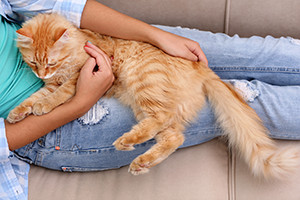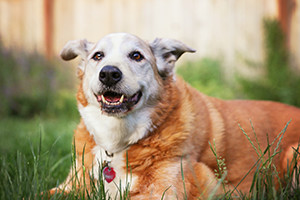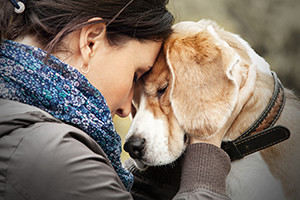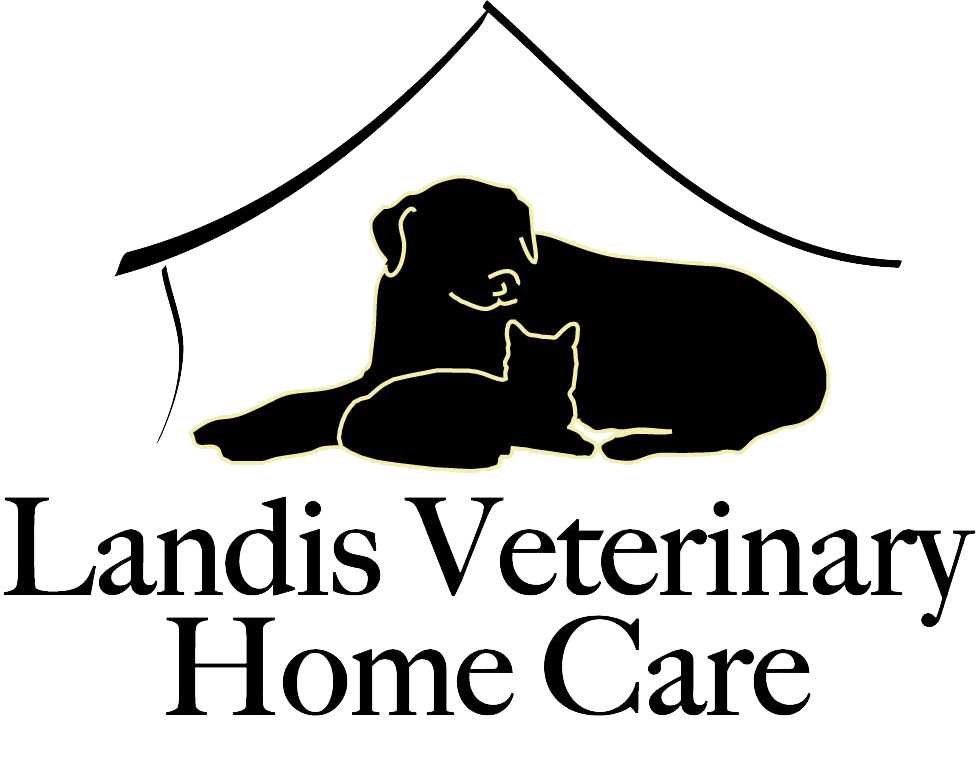Palliative Care

Palliative care is like hospice in that it is focused on caring and not a cure. The main difference is that we cannot readily predict how long the pet has left to live. Conditions such as arthritis pain, senility, dental problems, kidney, liver, heart and other systemic diseases are frequently seen in older pets and can diminish their overall quality of life. While modern veterinary medicine offers medical and surgical options that can be of benefit, not every pet is a good candidate for these interventions. Other complicating factors including multiple diseases, fear of the veterinary hospital or family budget constraints may make palliative care the best choice. Dr. Lori’s goal is to manage the pet’s problems to provide the best possible quality of life for her patient (and the family), while respecting the family’s goals and limitations.
Hospice Care

What is hospice care for animals?
Hospice care for animals is based on the philosophy that death is a natural part of life and that animals too, can live their last days with dignity at home with their families. Depending on the pet’s condition hospice care may last only a few days or could go for several months. The focus is on comfort and quality of life including alleviation of physical pain and emotional suffering of the whole family, enabling a safe, caring end of life experience. In animal hospice the “patient” includes the terminally ill pet and the family.
While animal hospice can be a compassionate caring option, owners must be aware that this choice may not be right for every pet or every pet parent. Home hospice involves training family members to perform the day to day care of a terminally ill pet. It is emotional and time-consuming work. For busy families, people who have a heavy work schedule or those who live alone or are not in good health, hospice may not be the right decision. In addition, hospice care can be costly over time and pet parents should consider carefully whether they have the necessary resources both in time and money to care for their pet at home. Dr. Lori can talk with you about your individual circumstances and help you decide if this is the right option for your family and your pet.
What to Expect?
Dr. Lori will:
- Talk with you about your goals and help identify what good quality of life means personally for your pet.
- Work with you to develop specific guidelines to help determine the point at which your pet’s quality of life is no longer acceptable, and euthanasia should be considered.
- Will make sure you and your family know how to provide proper care and nutrition for your pet.
- Discuss how to monitor and document your pet’s pain level and general health.
Once this instruction is complete, you and your family will take over the day to day care and monitoring of your pet. Dr. Lori or her certified veterinary technician (animal nurse) will set up regular visits to monitor your pet’s condition and make any necessary adjustments to the treatment or pain control plan. Regular communication is maintained by phone, text or email to be sure your pet is comfortable and that you do not have any questions.
When the end comes…
While hospice provides an alternative for patients with cancer or other terminal illness, it is not a substitute for euthanasia. In some cases hospice patients can die a natural death comfortably at home, but most of the time hospice serves as an intermediate stage between diagnosis and euthanasia. Caring for your pet in such an intimate way can make it difficult to make the decision to say goodbye. For this reason, Dr. Lori recommends reviewing your pet’s QOL guidelines regularly to be sure of his or her overall comfort level. When pain relief and quality of life can no longer be maintained, euthanasia can be a final gift of comfort to a suffering friend.
In either circumstance Dr. Lori will take this journey with you and help guide you through to the final loving and peaceful goodbye.
Euthanasia

In-Home Euthanasia – A peaceful goodbye to a beloved friend
Euthanasia literally means “good death”. It involves a gentle and pain-free death chosen for reasons of mercy. Dr. Lori is often asked how she can do this part of her job. While it is a sad time for all involved, she feels that it is an honor and privilege to be present at the end of a pet’s life. Her goal is to help ease their transition and to guide the family through this difficult time.
How to know when it is time for euthanasia
Making the decision to end your pet’s life is a very stressful process. Others in your life will often have opinions and well-meaning advice to offer, which can make you feel even worse. It is important to remember that this is a uniquely personal decision and each family and pet will have different circumstances. Ultimately you are best equipped to make that decision for your pet.
Sometimes it can be useful to have the advice of a professional when facing the possibility of euthanasia. If you feel this is the case, you can contact Dr. Lori to schedule a consult. She will discuss your pet’s disease trajectory, help you determine your pet’s quality of life and work through the decision making process with you. This also gives you and your pet an opportunity to become familiar with her ahead of time and to discuss the euthanasia process, aftercare options and to help determine if it really is time to say goodbye.
Generally, when there are more bad days than good days or the bad days are much worse, you need to be thinking about saying goodbye. Sometimes this means pain can no longer be controlled adequately. It may be that your pet can no longer enjoy the things that make him happy such as walks and playing. For more help in determining your pet’s quality of life, print out the Quality of Life Scale
and review it on a regular basis as things change with your pet. To help determine if your pet is in pain, see Common Signs of Pain in Dogs and Cats
What to expect during a home euthanasia visit:
Home euthanasia is a peaceful process that takes place in the comfort of your pet’s familiar surroundings. Dr. Lori will treat your family and pet with compassion and respect to provide a gentle transition without struggle or fear. Prior to the visit, she will talk to you to set up a time, answer any questions you have and discuss options for care of your pet’s body. During this call, she can also give you an idea of the costs involved and make payment arrangements. (See Fees here)
When Dr. Lori arrives at your home have your pet in the area you have decided upon. Before the euthanasia, you will need to sign a paper stating that you are the lawful owner of the pet, that he has not bitten anyone in the last 14 days, and that you give Dr. Lori permission to perform the euthanasia. Unless it has been handled in advance, payment will also be taken at this time so that the remainder of the visit can be devoted to you and your pet. (If you wish to pay by credit card you have the option of paying ahead of the visit through Square Up.)When all are ready, Dr. Lori will give your pet an injection of a sedative with a pain reliever. He may feel a bit of a pinch or sting when it is given, but this only lasts for a moment and some pets do not feel it at all. It will usually take anywhere from 3 to 10 minutes for the sedative to take full effect, enabling him to enter a deep state of relaxation and sleep without pain. Once the sedative has taken full effect and you are ready, Dr. Lori will give the euthanasia injection into a vein, usually in one of the legs, or sometimes in the abdomen. This final injection is pain-free and is essentially like an overdose of anesthesia. The pet quickly and gently enters a deep sleep and then the breathing and heart stop. Sometimes after an animal has died there is a bit of movement of the muscles (twitching), and stool or urine may be passed. Your pet’s eyes will likely remain open after death- this is normal. These things can sometimes be upsetting for the family but not for the pet who is not aware of any of it.
If you have arranged for Dr. Lori to cremate your pet’s remains she will take the body with her after you have had enough time to say goodbye. For families who are interested, she can make a clay paw print for you before she leaves. There is no additional fee for this keepsake.
Body Aftercare
Dr. Lori encourages you to think ahead about how you wish to take care of your pet’s physical remains. It is easier to make these decisions when you are not overwhelmed with grief. Below is a list of options available to you:
Burial: Some people prefer to bury their pets at home. This can be a nice option if you have children and can aid in the closure process. Not all towns permit burial on private property so you will need to check with your specific jurisdiction or homeowners’ association regarding regulations. Burial at a pet cemetery is another option. You can find local pet cemeteries (link to resource section) listed in the Resources section of this website.
Private Cremation: With this option, your pet is cremated in an individual chamber and his cremains (ashes) returned to you in a traditional wooden urn with a brass nameplate. Dr. Lori can assist you by taking your pet’s body with her after you say goodbye. The cremains are usually ready within 7-10 days. Dr. Lori uses Agape Pet Services in Boonsboro. If you prefer, Agape also has an option for you to transport your pet’s body yourself so you can be more personally involved, and if desired, view the cremation.
The crematory has a selection of complementary urns that are included in the cost of the cremation. They also have additional urns and keepsakes that can be purchased at an additional cost. Go to Pet Urns and Memorial Items for more information.
Communal Cremation: This option is a non-private cremation where your pet is cremated with other animals and the ashes buried on 40 acres of protected land near Antietam National Battlefield. This is the least expensive option for care of your pet’s remains and in no way denigrates his memory or dignity. Dr. Lori can still assist you by taking your pet’s remains with her after you say goodbye.
Chronic Pain Management

There are many forms of pain (i.e. injury, surgical, arthritis, cancer) but they can generally be divided into 2 types – acute (adaptive) and chronic (maladaptive). Acute pain is obvious and often associated with vocalization. Chronic pain may be subtle and viewed as “getting old” or “slowing down”. Old age is not a disease, but chronic pain is and should be addressed. Chronic pain (including cancer pain) is now considered a separate disease process with actual changes occurring in the nerves and brain that require a different approach to treatment than for acute pain. To ensure the best comfort for your pet Dr. Lori may recommend multiple modalities such as physical therapy, laser therapy, acupuncture, nutritional support, and supplements in addition to traditional pain medications. Dr. Lori has a special interest in managing pain in animals and will develop a treatment plan that is specific for your pet’s needs.
